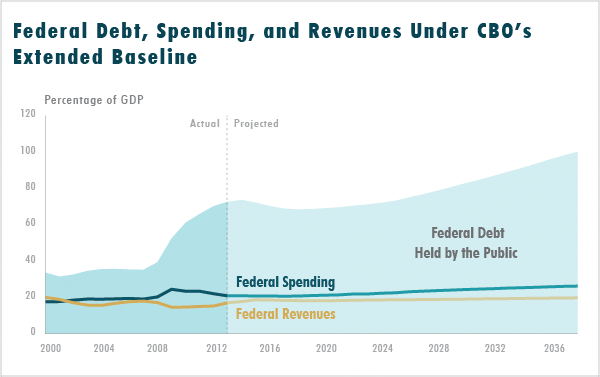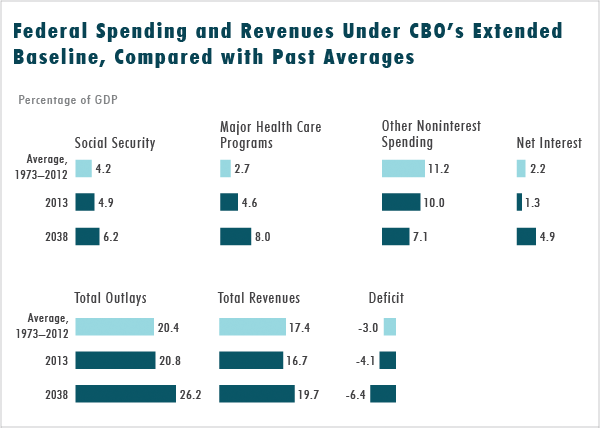I was pleased to participate on Tuesday in a conference on the budget organized by the Rudman Center at the University of New Hampshire. (The Rudman Center is named in honor of Warren Rudman, who served as a Senator from New Hampshire between 1980 and 1993.) At the beginning of the panel on which I spoke, I offered the following thoughts based on CBO’s recent analyses:
Federal debt held by the public is now about 72 percent of GDP—its highest level in our history except for a brief period around the end of World War II. If current laws generally remain in place, federal debt would be roughly the same, high percentage of GDP 10 years from now. And under CBO’s extension of the current-law baseline, debt would reach 100 percent of GDP 25 years from now.

I’d like to make three points about the budget outlook that are crucial for lawmakers and citizens to understand.
First, high federal debt has a significant cost in the long run. Even if debt never rose any further as a percentage of GDP, future wages and incomes would be lower than they would be with less debt. Also, lawmakers’ ability to respond to future financial crises, recessions, and international threats would be much more constrained and the risk of a fiscal crisis would be higher than if we had less debt.
None of that implies that high debt is the only challenge the country faces or necessarily the largest challenge we face. At a panel last March about the state of the economy, I said that the most visible and costly economic problem in this country today is the large number of people who cannot find jobs. But the high, and ultimately rising, level of federal debt is a significant problem as well.
My second point is that the growth in debt that CBO projects is driven not by a general increase in the size of the federal government but by growth in the cost of a few large programs. In our extended baseline, we project that outlays for Social Security and the major health care programs—in particular, Medicare and Medicaid—will be twice as large relative to the size of the economy in 2038 as they have been, on average, during the past 40 years. Three-quarters of the projected growth in those programs over the next 25 years stems from the aging of the population and rising health care spending per beneficiary; the remaining quarter owes to the expansion of insurance subsidies under the Affordable Care Act. Even after that expansion is in place, about three-fifths of all federal spending for the major health care programs will finance care for people over age 65, one-fifth will finance care for the blind and disabled, and only one-fifth will finance care for able-bodied nonelderly people.
Meanwhile, by 2020 under current law, federal spending apart from that for Social Security and major health care programs will drop to its smallest percentage of total output in more than 70 years. That broad category includes federal spending that represents investment in physical infrastructure such as highways, in education, and in research and development. Also by 2020 under current law, federal revenues will be a larger percentage of output than they have been in 30 of the past 40 years. Still, the rising cost of those few large programs, along with growing interest on the debt, would lead to widening deficits.

My third point is that the task of deficit reduction is complicated by the economy’s slow recovery from the severe recession. By CBO’s estimate, the economy is now about 5 million jobs short of where it would be if the unemployment rate was down to its sustainable level and participation in the labor force was consistent with its prerecession trend. The primary cause of the lack of jobs is a shortfall in the demand for goods and services relative to the productive capacity of the economy and thus a shortfall in the demand for workers. The main reason demand is weak is the lingering effects of the housing bubble and financial crisis. Also contributing, however, is the most abrupt fiscal tightening that has occurred since the end of World War II, with the deficit shrinking from about 10 percent of gross domestic product (GDP) in fiscal year 2009 to about 4 percent in 2013. Although that tightening has had the beneficial effect of slowing the accumulation of federal debt, it also has slowed economic growth during the past few years.
Thus, lawmakers face difficult trade-offs when deciding how quickly to carry out policy changes that would make the path of federal debt more sustainable. Policy changes that led to less fiscal tightening in the near term but greater tightening in later years would improve the economic outlook for both time horizons relative to our current projections.

